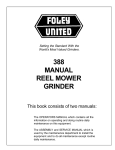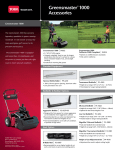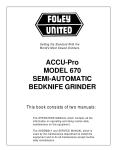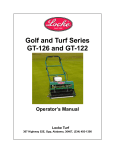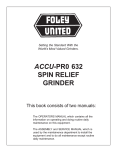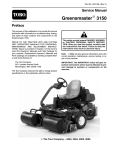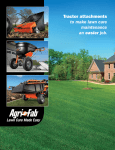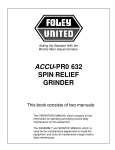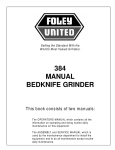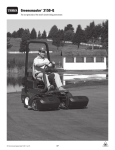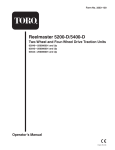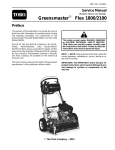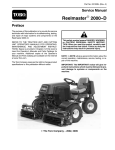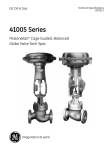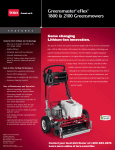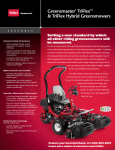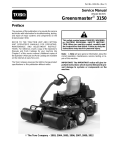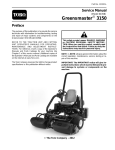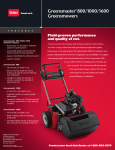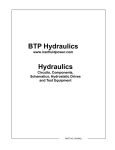Download Reel Mowers 1 Table of Contents
Transcript
Reel Mowers 1 Table of Contents Historical Background......................................................................................................2 Theory of Operation.........................................................................................................6 Importance of the Operator ...........................................................................................16 Preventive Maintenance ................................................................................................17 Set-up and Adjustments ................................................................................................19 Aftercut Appearance......................................................................................................28 Sharpening ....................................................................................................................30 Bedknives, Rollers and Accessories..............................................................................42 Groomers.......................................................................................................................46 Thatchers.......................................................................................................................49 TORO® Service Training 2 Reel Mowers Historical Background The concept of the reel mower goes back to the 1800's. It evolved out of a need for groomed turf areas being maintained on a regular basis. The first reel type fairway gang mowers were horse drawn. Here is an example of a horse drawn three gang fairway mower. TORO® Service Training Reel Mowers 3 The first tractor drawn gang mower. (Toro “Bull” Tractor in 1926). Golf course development during the 1920’s and 30’s brought about design improvements in engines and mower drive systems. These improvements continued, allowing for lighter weight and easier to use equipment. TORO® Service Training 4 Reel Mowers Productivity and quality of cut improved. The development of hydraulics during the 50's and 60's improved the reliability, safety, operator comfort and lowered maintenance costs. With the introduction of the riding greens mower, the industry reached new heights in the areas of productivity and efficiency. TORO® Service Training Reel Mowers 5 The introduction of hydraulically driven cutting units greatly reduced wheel slippage and the resulting turf stress. Although dramatic improvements have been made in reel type mowers, some of the same frustrations that developed working with reel cutting units years ago are still present today. TORO® Service Training 6 Reel Mowers Theory of Operation This section will describe the construction and cutting action of a reel mower cutting unit. When properly maintained and operated, reel mowers provide superior cut quality. These mowers are typically dedicated to cutting formal turf areas such as golf course greens, tees and fairways. If reel mowers' unique characteristics are not understood and responded to, the end result will be a poor quality of cut and expensive down time and repairs. reel bedknife rear roller frame front roller There are three main structural members in a reel cutting unit: The REEL consists of varying numbers of helix shaped blades attached to support spiders which are mounted on a rotating shaft. The BEDKNIFE is attached to the bedbar and the assembly is mounted to the main frame in a manner that allows for paralleling and adjustment to the reel. The FRAME supports the rollers, the bedbar assembly and reel with it’s drive mechanism, which can be hydraulic, belt driven or ground driven. A reel mower cuts grass with a scissors-like shearing action as the moving helix shaped blades pass over the stationary bedknife. The cutting action requires that the bedknife and reel blades be sharp, matched, and in close relationship with each other. TORO® Service Training Reel Mowers 7 The reel (cylinder) consists of a number of helical blades welded to supports called spiders. This weldment is then ground to be a perfect cylinder. Construction Details Reel Reel Blade Spider The reel is rotated by a drive system, usually a hydraulic motor. Below the reel is the bedbar assembly. The bedknife is held rigidly in position to and by the bedbar. Shaft The bedknife is sharpened to be flat and square so the sharp edge contacts the reel cylinder across its entire length. Bedknife Bedbar If the bedknife is not flat or the reel is not a prefect cylinder it is impossible to get the bedknife to contact along the entire length of the reel cylinder. Construction Details Side Plate Frame The reel is supported by precision bearings held within the side plates. The side plates are held in place by a frame. This becomes the reel assembly and is a precision cutting tool. The reel assembly is supported by rollers and pulled along the ground by a carrier frame. Bedbar Assembly TORO® Service Training Bedbar Pivot Bolt 8 Reel Mowers Terminology This drawing depicts the common terms used when referring to a reel mower. We have already discussed the reel and the bedknife. The attitude refers to the angle of the bedknife. This reference is in degree differential from the plane of the earth (or the line intersecting the bottom of the rollers). The shear point is the point that the reel contacts any given point on the blade at a specific point in time. The reel centerline is the imaginary line drawn perpendicular to the turf dissecting the reel at its center. This line is used to find the Behind Center Distance or BCD, this is the distance the shear point lies behind the centerline. There are two rollers, one roller must be fixed and therefore must be parallel to the reel on all axis. The rear roller trails the cutting unit and is usually a solid roller. The front roller leads the cutting unit and due to the forces working on it can be any one of many styles. The Height of Cut or HOC defines the distance between the roller plane and the shear point. Some cutting units have a fixed front roller and the rear roller is used to set the height of cut. Others, such as the newer DPA design cutting units have a fixed rear roller and the front roller is used to set the height of cut. TORO® Service Training Reel Mowers 9 Think of the reel mower cutting action like a scissors; two blades coming together with light contact to cut the grass. This shows the cutting action of the mower as viewed from turf level (below the cutting unit). Clip To understand reel cutting theory, you must understand the concept of clip and the shear point. A shear point is any single point of contact made between the reel blade and bedknife. Here we can see the distance between two successive sheer points, one factor that affects the clip rate. TORO® Service Training 10 Reel Mowers Clip is the forward distance traveled between successive blade contacts at one shear point. This is viewed as a single contact point on the bedknife. As the reel travels forward it pushes the grass in front of it, at the same time the reel blade is gathering the grass behind it as it travels toward the bedknife. The opposing forces working on the grass bunch the grass together at the shear point creating a triangle Cutting Action By following the blade path through two “clips” as the machine moves forward we can illustrate the actual process of cutting grass. The bedknife pushes grass toward the shear point while the reel blade gathers it in front. Each blade path has one-half clip in which to cut all the grass. TORO® Service Training Reel Mowers 11 Factors that affect the clip rate: • • • • Diameter of reel Number of blades Speed of reel Ground speed If we observe multiple clips we get a series of triangles set side by side. The top of the triangle represents the individual shear point. The clip rate is therefore the distance between the tips of the triangles. The clip rate is critical to the appearance of the cut. Ideally, the clip rate should equal the H.O.C. The ideal situation is when H.O.C. = Clip Rate Factors that affect the Clip Rate are listed in the illustration. Can you explain why they would affect the clip? How does engine RPM affect clip? Generally the lower the HOC (height of cut) the more blades are required to keep the clip range in sync. A greens mower cutting unit, for example may be available with 11 or 8 blade cutting units. An optional 5 blade reel may also be available for some greens mowers. Why would you use a 5 blade reel on a greens mower cutting unit? Most cutting units have a preferred operating range and All cutting units can be adjusted beyond that preferred range. Choose a cutting unit where the intended HOC is in the middle of the HOC range. Generally, larger diameter reels work better with warm-season grasses and smaller diameter reels with cool-season grasses. Clip This effect of clip can be noticeable and can result in the ability to actually see the individual shear point in the cut. The shear points show up as a “corrugation” pattern. NOTE: If you change height of cut, you may notice some corrugation after the first mowing. This will go away after the grass is maintained at this height over a period of time. TORO® Service Training 12 Reel Mowers Other terms or processes often discussed concerning reel mowers are: • Height of cut versus clip • Corrugation • Fanning • Bedknife front angle. Height of Cut vs. Clip is an important concept that must be understood before selecting mowing equipment, adjusting the height of cut or determining a proper mowing speed. This is an extreme case corrugation. Because of an imbalance between height of cut and clip, the grass is cut with extreme valleys and peaks. H.O.C. vs. Clip and Fanning Note that the grass outside of the forward half clip is not easily gathered. The general rule concerning height of cut vs. clip is that both measurements should be within 20% of each other. The best results will be obtained when height of cut is equal to or close to the clip. Grass extending beyond the forward half clip, yet tall enough to be within the blade path is less likely to be cut. Reel blades may contact the grass in this area several times prior to the actual gathering of the grass. This is the so called “fanning” process. This process is more a mechanical striking of the grass that it is of the commonly thought effect of a blowing action. TORO® Service Training Reel Mowers 13 The speed of the reel can be adjusted on some machines. As we have discussed, it is important that the reel speed be matched with the number of reel blades and the forward speed of the tractor. Reel Speed Chart The importance of the bedknife front angle is visible from the side view. Note that the proper angle allows the grass behind the bedknife front edge to be more effectively cut. Bedknife Angle Bedknife Angle Sheer Point A front view illustrates the angle between the bedknife and the reel blade which is called the helix angle. Helix Angle Helix Angle TORO® Service Training 14 Reel Mowers Another term, known as “the cutting path”, is the result of the helix angle and the forward motion of the cutting unit. The shear point moves down the bedknife as the bedknife moves forward. The grass is physically cut at an angle to the bedknife. As the reel rotates the area of contact (sheer point) moves down the reel blade and knife. Cutting Path / Sheer Point Single Reel blade edge We can see this by following the blade highlighted in green. Sheer point Cross section of turf cut at various heights 1/2” (13 mm) 1” (25 mm) 1-1/2” (38 mm) Other factors which affect reel mowing are the grass density and the grass acclimation or grain. Grass tends to thicken at the normal maintained height of cut. The denser the grass, the easier it is for the bedknife and reel to gather it. Grass density and grain can often override other factors we have discussed regarding the cutting action. 2” (51 mm) TORO® Service Training Reel Mowers Requirements for good performance 15 The basic requirements for good performance of reel mowers are: • The cutting edges on the reel blades and bedknife must be straight and sharp. • The bedknife must be exactly parallel with the reel. • The bedknife should be positioned against the reel with light contact. When properly maintained and operated, reel mowers provide superior quality of cut. It cannot be overstated that reel mowers are precision tools. It is essential that they be adjusted and operated with this in mind. This illustrates a nice clean cut with all five cutting units on a fairway mower set-up and adjusted the same. Here, the cutting units are not set-up the same, or have different wear patterns between the individual cutting units. This can cause a mismatched appearance across the width of the mower. Reel mower performance depends on proper set–up and adjustment procedures. An error of .010 inch or .25 mm in height, end–to–end, or from one cutting unit to another, can be visible in the turf. In after-cut appearance terms, this is known as “mismatch”. TORO® Service Training 16 Reel Mowers Importance of the Operator and Equipment Manager The Operator has a significant influence on the quality of cut that a reel mower can deliver. The large investment in specialized mowing equipment cannot be jeopardized by unqualified operators. Before an operator can be considered qualified to operate a piece of equipment, there should be a significant effort by the supervisor towards their training and familiarization with each piece of equipment. Make sure the operator reads and understands the Operator’s Manual. Have the operator watch the Operator Training Video and take the on-line quiz at Toro.com Customer Care. Then, you should explain any unique methods or procedures used on your grounds. A supervisor should play a key role in establishing the proper attitude and behavior patterns toward operating turf equipment. A supervisor should not create the impression that a few minutes orientation on a piece of equipment will qualify the operator. Operators and service technicians play a significant role in determining quality of cut, down time, and life of mowing equipment. Make a commitment to train and familiarize staff with each product. Remember, that each type of mowing equipment will have specific operating characteristics, and noise qualities. Operators should become familiar with the product and listen for any unusual changes. Concerns should be reported to the service technician before significant problems develop. TORO® Service Training Reel Mowers 17 Preventive Maintenance To get the most out of your equipment investment, it is important to have a good preventive maintenance program. Doing scheduled maintenance and adjustments will prolong the life of your equipment, help prevent expensive downtime, and give the best possible quality of cut and performance. Experience has shown that a high percentage of problems that occur in turf equipment have developed over a period of time and could have been prevented by adjustment, lubrication, or other required maintenance. Follow the maintenance and adjustment recommendations listed in the Operator’s Manual. Some products may also have a Quick Reference maintenance decal on the machine. Recommended maintenance intervals should be considered minimum requirements. If the equipment is operated in particularly harsh conditions, such as very hot weather, during the “grow in” period after construction, or on top dressed greens, these procedures may have to be performed more often. Use original Toro parts when doing maintenance or repairs. These parts have been tested and designed for this specific, very demanding, application. “Will fit” parts may look the same and fit, but they can give totally different performance. Don’t take a risk on your important equipment investment by saving a little money now that can cost you expensive repairs or increased maintenance intervals later. The operator and service technician should make a thorough visual examination of the product each day. This can identify oil leaks, low oil levels, loose or bent components and abnormal noises. TORO® Service Training 18 Reel Mowers Information Resources The maintenance charts and Operator's Manuals should be used for reference to identify specific areas requiring ongoing scheduled maintenance. Service Manuals and Training Guides are also available from your Toro Distributor for many models. Information about Service Education Materials, Maintenance Schedules, Service Bulletins and more is also available on the Internet at: www.toro.com Mowing equipment is designed for a specific application and should be operated keeping those restrictions in mind. Accidents and personal injuries can be minimized if persons will keep thinking and be aware in their every day work habits. TORO® Service Training Reel Mowers 19 Setup and Adjustments The following slides will cover basic requirements for cutting unit set-up and adjustment. Always use the instructions in the Operator’s Manual or Service Manual when working on a specific model. Reel mower performance depends on proper set–up and adjustment procedures. An error of 0.010 inch (.25 mm), in height end–to–end, or from one cutting unit to another, is visible as a mismatch on many golf course greens. Although there are design variations in cutting units, most require the same basic procedures. A surface plate, accurate height of cut tools and proper instruction are essential for setting up a cutting unit. Factors that affect quality of cut • Tire pressure • Engine governed speed • Reel bearing condition/adjustment • Reel and bedknife sharpness • Bedknife parallel to reel • Bedknife to reel contact • Bedknife attitude (angle) • Roller(s) parallel to reel • Height of cut (bench set vs. actual) • Correct bedknife • Cutting unit alignment and ground following • Roller and roller bearing condition • Reel speed • Traction speed • Cutting unit drop speed and sequence • Cutting unit counterbalance or down pressure setting There are many factors that can affect quality of cut, including condition of the mowing equipment and agronomic factors. Turf conditions such as excessive thatch, “sponginess” or attempting to cut off too much grass height may not always be overcome by adjusting the machine. It is important to remember that the lower the height of cut, the more critical these factors are. Remember that the “effective” or actual height of cut depends on cutting unit weight, cutting unit accessories and turf conditions. Effective height of cut will be different than the bench set height of cut. Effective height of cut is the actual height the grass has been cut. Making an accurate height measurement on the turf is difficult due to many variables. A true base is simply not present. If the surface is uneven, spongy or varies in density, color variations in the turf may appear in the form of a streak. This is due to the effective height of cut being too low for the existing turf conditions. To correct problems, start or change a cultural practice, change cutting unit configuration or raise the bench set height of cut. The lower your height of cut, the more predictable and smooth the turf surface must be. To accurately maintain height of cut and performance, routinely check the following components: • • • • • Reel Bearings Bedknife to Reel Adjustment Attitude Adjustment Roller Parallelism Height of Cut TORO® Service Training 20 Reel Mowers Reel Bearings Check reel bearings for play and roughness. Replace if necessary. If adjustable (tapered roller bearing), adjust to “no“ lash while maintaining free rotation of the reel. Reel bearings must be in good condition and properly adjusted for the reel to work properly. The area where the seal rides needs to be checked for undercutting. If the reel bearing has failed check the shaft carefully. If the bearing spun on the shaft the reel may need to be replaced. There are many different configurations of bearings and seals but there are two basic groups: • Ball Bearings • Tapered Roller Ball Bearings Ball bearings are designed to be loaded in the vertical direction only. There can be no side load applied unless the bearing was specifically designed for it. Reel bearings are not. With this type of bearing the side movement is taken up until the only movement is the play of the bearing itself. Ball bearings can come as sealed components or as open bearings where service would require greasing. Load Direction Tapered Roller Bearings Taper roller bearings on the other hand require a preload horizontally to properly carry a vertical load. With this type of bearing there is generally a torque used to set the preload. Bearing torque becomes a critical adjustment and part of the preventative maintenance program. When this type of bearing is used there should be no side play. TORO® Service Training Reel Mowers 21 Rollers Greasing a bearing after every use and after any washing not only lubricates but purges water which is responsible for the majority of bearing failures on this type of equipment. Before performing any set–up procedures, it is critical that the reel and knife cutting edges are straight and sharp. Lap or grind as necessary. Adjust as needed to ensure the knife and reel contact their full length with LIGHT contact and free reel rotation. Bedknife to Reel Adjustment Dual Precision Adjustment (DPA) TORO® Service Training Note that different cutting unit models have different methods of adjusting reel to bedknife contact. The top illustration shows a four bolt style adjustment mechanism. The bottom illustration shows a single point adjustment mechanism. Single point adjust cutting units also have an adjustment mechanism on one end of the bedknife for adjusting the bedknife parallel to the reel. This illustration shows the dual precision adjustment (DPA) mechanism, used on the newer Toro cutting unit designs. On this Greensmaster DPA cutting unit, each click of the adjustment screw results in .0007 inch (.0178 mm) movement of the bedknife; a VERY precise adjustment. On the Reelmaster DPA cutting unit, each click results in .0009 inch (.0228 mm) of movement. 22 Reel Mowers Adjust the bedknife against the reel to EVENLY pinch one paper thickness across the entire width of the bedknife, then cut paper strips to check blade sharpness. Put the cutting unit on the turf and check for light bedknife to reel contact and free reel rotation. Do a final adjustment of bedknife to reel contact if necessary. Parallel, Light Contact and Sharp “Pull and cut”: When the paper is used as a feeler gauge to set even contact across the bedknife, it is held parallel to the bedknife. The reel should pinch with the same amount of resistance at both ends, and the center. The “feel” of this measurement should be somewhat the same as pulling the paper between your finger while applying moderate pressure with your fingers. The paper must be held perpendicular to the bedknife in order to check sharpness by cutting the paper. If it is not perpendicular it can be pinched between the reel and the bedknife, this is possible even if the components are sharp. Properly adjusting the bedknife to the reel is one of the most effective preventive maintenance practices for reel mowers. The amount of contact and how frequently it is checked are major factors in performance. A light contact adjustment, if maintained, will help keep cutting edges sharp on the reel and bedknife. This requires that the adjustment be checked frequently at a predetermined time interval. Dulled cutting edges cannot be corrected immediately by adjustment or over–tightening. Do not wait until the quality of cut has deteriorated to check the bedknife to reel adjustment. If the cutting edges on the reel blades and bedknife are not straight and sharp the mowing results may not be acceptable. This is true even if all other set–up procedures are correct. TORO® Service Training Reel Mowers 23 Attitude and Behind Center Distance (BCD) of Bedknife The cutting unit attitude is the angle between the bottom of the bedknife and the ground plane under the cutting unit. As the bedknife attitude is changed, it is important to note that the reel to bedknife shear point changes relative to the center line of the reel (Behind Center Distance – BCD). This can change the after cut appearance of the grass. The result may be better or worse depending on several factors. Bedknife attitude is adjusted by changing the height of the front, rear, or both rollers. A height of cut change is NOT necessarily part of a change to the bedknife attitude. A large angle is also referred to as an aggressive bedknife attitude. A small angle (flat attitude) can have most or all of the bedknife riding ON the turf. This can influence after cut appearance. It will normally be an advantage to have the front or the cutting edge of the bedknife lower than the back. This helps prevent the bedbar from contacting the ground surface in low heights of cut. It will also prevent the streaking or ruffling of the turf after it has been cut and passed over by the bedbar. There is a limit on how much of a forward angle the bedbar can be positioned to. If the rear is positioned too high, the reel position can become lower than the cutting edge of the bedknife, tearing the grass and giving a poor quality of cut. TORO® Service Training 24 Reel Mowers This illustrates the bedknife BCD on a Greensmaster DPA cutting unit. DPA cutting units have a unique, patented, bedknife pivot that maintains the angle and behind center distance of the bedknife as the reel wears over time (reel diameter gets smaller). BCD: Greensmaster DPA Cutting Unit With other designs the attitude will change as the reel wears. This will require additional adjustments to compensate. The bedknife angle and the BCD have a direct correlation. Centerline Behind Center Distance (BCD) has a positive correlation to Bedknife Angle When one changes the other changes in the same direction. 00 BCD @ 00 As the angle increases to 2 degrees the BCD has also increased. Centerline Behind Center Distance (BCD) has a positive correlation to Bedknife Angle 20 BCD @ 00 TORO® Service Training Reel Mowers 25 At 7 degrees the BCD is even greater. Behind Center Distance (BCD) has a positive correlation to Bedknife Angle Centerline Increasing the BCD results in a more aggressive blade path. 70 BCD @ 00 Attitude An aggressive setting is: •Bedknife angle is extreme •The bedknife is further from the centerline of the reel An aggressive setting, means the bedknife angle is extreme. The bedknife is further from the centerline of the reel and the reel blades approach is from an aggressive angle. The result: A very crisp clean cut. Differences in up and back (stripe) pronounced. The down side is that any variation in reflections will be readily noticeable. •The reel blades approach is from an aggressive angle The result: A very crisp clean cut. Differences in appearance back and forth (pronounced stripe). Variation in reflection of light will be readily noticeable. Attitude Notice the lighter marks in the overlap area between cutting units. The affect of the cut usually appears as lighter marks. Darker marks are the affects of rollers. TORO® Service Training 26 Reel Mowers Attitude A flat setting (less aggressive) is: •The angle of the bedknife is flat •The bedknife is closer to the centerline of the reel With a reduction of BCD the reel does not gather grass as cleanly therefore the grass blades can be different lengths. This is by definition stragglers, however; the difference is negligible and tends to diffuse the reflective qualities of the cut grass thereby masking imperfections. •The reel blade approaches from a horizontal direction The result: A diffused appearance. Reflective variations cannot be seen as readily. The stripe is less defined. Cut is prone to stragglers. The result is that this aggressiveness of cut sometimes leaves marks or stripes on the surface of both putting greens and fairways that are unacceptable. The fact of the matter is that we’re not shearing carpeting. We’re dealing with a dynamic plant system that we insist on cutting at ridiculously low heights of cut, very cleanly, all the time and with very big machines. Rollers Parallel to Reel To achieve an acceptable quality of cut the rollers must be parallel to the reel. Before adjusting roller parallelism, check for loose roller bearings. Adjust or replace the bearings as necessary. First parallel the front or rear roller, which ever is NOT used for setting the height of cut. This paralleling roller is set to match the reel using a surface plate fixture. With the reel blades resting on a raised bar on the plate, use a feeler gauge along the bottom of the roller between the roller and plate. Newer DPA model cutting units, with a rigid, bolted frame, normally do not require this procedure. TORO® Service Training Reel Mowers Height of Cut (H.O.C.) 27 Set the height of cut to the desired height using an accurate tool. This procedure must be done exactly the same on each cutting unit. Before doing this adjustment the bedknife and roller not used for height of cut adjustment must be parallel to the reel as described on previous slides. As reel cutting unit design and configuration continue to evolve, height of cut settings may need modifying to retain visual and playability goals. Remember, the setting you are making here, the “bench set height of cut”, is different from the effective or actual height of cut in the turf Bench Set vs. Effective H.O.C. There can be a significant difference between a bench set HOC and the actual HOC when in the turf. The Bench set HOC is a theoretical HOC based on the assumption the rollers will set at the same place in the grass and that the turf is firm. The turf can have varying densities, different cutting unit models can weigh more or less, and the rollers do not always set in the grass in the same manner. In the circle above you see that after the grass is cut, the remaining grass must make it under the bedbar. There is not a lot of room for that to happen. If there is too much grass under the bedbar it can lift up on the knife causing rifling or the appearance can vary due to the rollers lifting from the turf as the bedknife becomes the support for the cutting unit. To avoid this we need to maintain a minimum amount of space for the grass under the bedknife. Clearance must be maintained between the bottom of the bed knife and the height of cut gauge. On average, at 1/8” (3.2 mm) height of cut a 0.020” (.51 mm) clearance will greatly decrease bed knife scuffing on the turf. TORO® Service Training 28 Reel Mowers Aftercut Appearance There are some basic patterns that can appear on turf maintained with a reel mower. The first pattern illustrates good adjustment procedures and properly maintained cutting edges. The second pattern shows many stragglers. This can be caused by: • • • • • • Incorrect bedknife to reel adjustment Dull cutting edges Mowing outside of the optimum clip rate Not using preparation devices such as a brush, comb, groomer or dew whip. Inconsistent turf texture and density Using the wrong type of roller The third pattern illustrates a single streak. This can be caused by: • • • • Rifled or uneven wear on bedknife Damaged area on bedknife from hitting an objects) Loose bedknife screws Bent reel blade The fourth pattern shows multiple streaks. This can be caused by heavy contact between the bedknife and reel, resulting in a “rifled” or wavy bedknife. TORO® Service Training Reel Mowers 29 It is normal for the mower to leave after–cut directional light and dark color paths. These overall color paths are due to the turf being rolled down in the direction the mower is traveling. A cut path going away from you will usually be lighter in color than the path coming toward you. Smaller, individual color variations can be due to differing turf types, density variations and straight line mower marks. A spongy area is evident by the momentary impression left by feet on the surface. Part No. 97931SL Model 04399 TORO® Service Training Many turf discrepancies are subtle and require closer examination. In these instances, the Turf Evaluator grass viewing tool is helpful. It can assist turf managers in determining causes for poor reel mower performance and comparing the effective height of cut of one mowed surface to another. 30 Reel Mowers Sharpening How can you tell if sharpening is necessary? • The grass is not cut cleanly • Streaks. • Stragglers. • The cutting unit is noisy. • “Its that time of year”. One sure way to determine the answer to this is by actually checking the cutting edges of the reel and bedknife to see if they are dull, nicked, bent or being run without light contact against one another. This profile drawing of the blades shows the result of wear. The leading edges are rounded and the angle of the bedknife has worn to match the circle created by the blade path. Reel blades, and the edge of the bedknife should be checked for damage visually and by carefully feeling the edges. Of course, this should only be done when it is certain that the reel cannot be started, and never slide your fingers down the edges lengthwise. Rounded edges on the reel blades and bedknife will cause the grass blades to be pinched and torn, rather than sheared off cleanly. When light contact is not maintained, dull edges will soon result. TORO® Service Training Reel Mowers Sharp vs. Dull Cutting Blades Cutting units should be kept as sharp as possible to: • • • • • • Promote growth of healthy grass. Optimize cutting unit performance. Extend the life of the mower. Maximize operator mowing time. Allow the tractor to run most efficiently. Provide excellent finished appearance of the turf. TORO® Service Training 31 32 Reel Mowers When the cutting unit blades become dull, and quality of cut deteriorates, the tendency is to want tighten the bedknife to reel contact, resulting in heavy contact. Rifling pressure Barrel Shaped Reel Heavy bedknife to reel contact can cause “rifling”; a grooved or wavy (rifled) reel and/or bedknife. This condition can only be corrected by grinding the reel and bedknife – BACKLAPPING WILL NOT CORRECT THIS CONDITION. The bedknife will usually need to be replaced, rather than just sharpened. A barrel shaped reel, caused by flexing of the cutting unit frame will also require sharpening to bring the reel back to a cylindrical shape. This only occurs only on some cutting units with welded frames and not on the newer DPA model cutting units with rigid bolted frames. If the reel wears unevenly, it becomes difficult to keep the bedknife parallel across the entire width of the reel. You may be able to pinch paper in the middle, but not on the ends, or vice-versa. When adjusting a cutting unit with this condition, the tendency is to want to tighten the bedknife to reel contact, so the paper can be pinched and cut across the entire bedknife and reel, resulting in heavy contact. Cone Shaped Reel Sharpening will also be required if the reel is “cone shaped” (tapered). All reels eventually become tapered with use. If the reel is not adjusted or ground to a cylinder shape again, a mismatch in the height cut between adjacent reels can result. TORO® Service Training Reel Mowers Sharpening Methods • Maintain proper ADJUSTMENT • BACKLAP the bedknife and reel • GRIND the reel and bedknife 33 There are several methods that may be used to sharpen a cutting unit. The one that you choose will depend upon the condition of the cutting unit. It should also make the most sense for the anticipated use. For example, if you are about to mow greens that have been core aerated or top dressed, you may not want to grind the reels and install new bedknives. Maintaining proper adjustment (light bedknife to reel contact) will keep the cutting unit sharp longer. As the reel blades run against the bedknife a slight burr will appear at the front cutting edge surface the full length of the bedknife. Occasionally run a file or facing grinder across the front edge to remove this burr to extend the cutting performance of the machine. Lapping must be done after single blade grinding. This is done to establish a “land area” and to insure a perfect match between the bedknife and the reel edge. Lapping is not intended to be a reconditioning process to correct severely nicked or rounded blades, rifling or taper. If, after 5 minutes of lapping, the edge is not restored, it is time to grind the reel. Lapping is often a regularly scheduled maintenance process, particularly with greens mowers. By back lapping regularly, reel blade and bedknife sharpness can be maintained. Back lapping CANNOT be used to sharpen a dull reel or bedknife. Back lapping is an edge maintenance practice. TORO® Service Training 34 Reel Mowers WARNING: Always use a brush with an extended handle to apply the lapping compound to the rotating reel. Using a short handle brush could cause your hand to be pulled into the reel, and cause serious injury. Keep your hands, feet and clothing away from moving parts ! If you use back lapping as a regular maintenance practice, back lap often, but for a very short time. Example: 2 minutes per cutting unit BACKLAP OFTEN but VERY LITTLE Approximately Two Minutes per Cutting Unit Before a reel can be sharpened correctly, the reel has to be cleaned and checked for loose or bent blades. The reel bearings must be in good condition, with no end play evident. Make sure the cutting unit frame and roller brackets are true and not bent or damaged from impacts with trees, posts or cart path edges. The cutting unit must be aligned so the grinding wheel will travel parallel to the reel shaft. This will result in the reel being ground to the desired cylinder shape. Follow the grinder manufacturer’s instructions for setup and operation of the grinder. When grinding, be careful to not overheat the reel blades. Remove small amounts of material with each pass of the grinder. After completing the grinding process, do a complete set–up and adjustment procedure on each cutting unit. TORO® Service Training Reel Mowers 35 Grinders WARNING ! Always wear a face shield or safety glasses when grinding or back lapping. TORO® Service Training There are several manufacturers of reel grinders. These same manufacturers also produce bedknife grinders. Remember to always wear a face shield or safety glasses when grinding or back lapping. 36 Reel Mowers It is important to understand that Toro reel mowers are designed and manufactured to optimize available power from the engine and hydraulic systems. To help do this, we put a “relief” on every reel blade to reduce the width of reel blade that contacts the bedknife. This has been proven to reduce power requirements, as well as allow the machine to operate more efficiently. This can be very important, depending on the terrain, type of grass and amount of grass being cut. Milled Relief (Scalloped Blades) Toro has two different methods of manufacturing reel blades with a “relief”. The reel blades are made from straight stock steel and then are either relief ground or the relief is milled in. Either way, there is a relief on the blade when it is manufactured. A small ground relief is also put on milled relief blades during manufacture. Toro greens mowers and DPA fairway cutting units are manufactured with a milled relief – other trim, utility and fairway mowers with a ground relief. Spin Grinding (Flat Grinding) There are two methods of grinding reels. This slide illustrates Spin Grinding (which is also know as “Flat Grinding”). With this method, both the reel and the grinding stone are turning as the reel is being sharpened. It is sometimes stated that back lapping is not required after spin grinding, because the reel is a perfect cylinder when grinding is completed. This depends on proper alignment of the reel in the grinder before sharpening. Also, the bedknife and bedbar must be straight and perfectly parallel to the reel when it is mounted. Back lapping will remove burrs and rough edges, producing a honed edge that will cut grass evenly. If using a spin grinder to sharpen straight stock reel blades (such as on fairway mowers) some or all of the relief will be ground off. If you are going to restore the relief that was on the blade when was manufactured, you will need to also use the other method of grinding (single blade “relief” grinding). It is recommended to do the relief grinding first, then spin grind to restore the reel to a cylinder shape. TORO® Service Training Reel Mowers 37 This slide illustrates Single Blade Grinding (which is also know as “Relief Grinding” or “Back Grinding”). Single Blade Grinding (Relief or Back Grinding) With modern grinding equipment, spin (flat) grinding and single blade grinding are available on the same machine; spin grind to sharpen and return the reel to a cylinder shape, then single blade grind if necessary, to restore the relief or back grind. Toro recommends a 30 degree relief angle on each reel blade. The angle itself is not critical. You can put as little or as much angle on the blade as you think is proper. A larger angle will take off more steel and the reel may have to be replaced sooner. With a smaller angle, you may have to grind the reel more often to maintain a relief. Whichever grinder you use, be sure to compensate for a cone or barrel condition. Reel Grinding Grind parallel to the Reel Shaft Do Not grind by equaling the spark pattern on each end A=B • • • • Grind parallel to the Reel Shaft Do Not grind by equaling the spark pattern on each end. Reels naturally wear more on one end then the other. Verify the reel centerline (reel shaft) is parallel to the grinder stone travel. B A Bedknife Installation If replacing the bedknife it is important to use the following procedures: • • • TORO® Service Training Remove all rust, scale and corrosion from the bedbar surface before installing new bedknife. Make sure the bedbar threads are clean. Use new Toro screws. Apply anti–seize lubricant to the screw threads before installing. 38 Reel Mowers Tighten the screws working from the center toward each end of the bedbar. DO NOT use an impact wrench. Fairway/utility mowers: 250 – 300 in-lb. (288 – 345 KgCm) Greens mowers: 200 - 250 in-lb. (230 - 288 KgCm) Since there can be variations in the mounting surface of the bedbar, a new bedknife may not be perfectly flat after it is installed. Because of this, it is necessary to back lap or grind a new bedknife after installing it to the bedbar. Follow the existing angle that was ground into the bedknife and grind only enough to make sure the top surface is true. When regrinding a bedknife it is important to use the following procedures: • • • Remove the bedbar and bedknife assembly from the cutting unit before attempting to grind a used bedknife. Keep the bedknife fastened to the bedbar when grinding. When grinding, be careful to not overheat the bedknife. Remove small amounts of material with each pass of the grinder. TORO® Service Training Reel Mowers 39 .050 ± .015 Top View Side View Lead-in A lead-in provides a softened entry for the leading side of the reel blade helix as it approaches the bedknife. This helps eliminate rifling caused by heavy contact and vibration. If the bedknife had the lead-in originally, be sure to put it there when done grinding the bedknife and reel. Example specifications for this lead-in for a fairway mower knife are as shown. These specifications are only a suggestion. The idea is to get a grind in place not to spend a lot of time making sure it is exact. Using a file to make the lead-in is a perfectly acceptable method. It is important not to make the lead-in too long or you will notice that there is a streak left behind at the edge of the cutting unit as the reel will not cut well in the area of the grind or may adversely affect the overlap area. It is also important that the lead-in make a smooth transition. Be sure to remove any burr that develops as a result of making the lead-in. The lead-in will lessen as a result of bedknife wear and should be redressed with a file at the same time the ears are removed. • The EdgeMax™ bedknife includes a leading edge of harder steel The EdgeMax™ bedknife includes a leading edge of harder steel. • Holds an edge twice as long and reduces the need for adjustments, back lapping and grinding The EdgeMax bedknife Holds an edge twice as long and reduces the need for adjustments, back lapping and grinding. • Set bedknife to reel adjustment as usual Set the bedknife to reel adjustment on an EdgeMax bedknife as usual; Light contact while running on the ground. – Light contact while running on the ground • No special requirements TORO® Service Training Thee are no other special requirements 40 Reel Mowers Maintaining the EdgeMax Bedknife Maintaining the EdgeMax Bedknife • A dull knife must be sharpened • If back lapping is part of your maintenance practice, be prepared to back lap for two to three times the amount of time as compared to a standard bedknife • Front face grinding is acceptable in moderation – Any facing or grinding must be done with exacting tolerances. Do not use a hand held grinder • • • A dull knife must be sharpened. If back lapping is part of your maintenance practice, be prepared to back lap for two to three times the amount of time as compared to a standard bedknife. Front face grinding is acceptable in moderation. Any facing or grinding must be done with exacting tolerances. Do not use a hand held grinder. Grinding the EdgeMax Bedknife Sharpening the EdgeMax Bedknife • No special stones required • Dress the stone more frequently – Before starting and at least once during grinding • One pass to dress – Multiple passes will cause the stone to back up • When grinding, remove smaller amounts of material (shallower cut) • Expect a different spark pattern Mild Steel: Many orange visible streaks with few sparks • • • • • • • No special stones required Dress the stone more frequently Before starting and at least once during grinding One pass to dress Multiple passes will cause the stone to back up When grinding, remove smaller amounts of material (shallower cut) Expect a different spark pattern Tool Steel: Few visible streaks with noticeable sparks TORO® Service Training Reel Mowers TORO® Service Training 41 42 Reel Mowers TORO® Service Training 42 Reel Mowers Bedknives, Rollers and Accessories Bedknife design must allow for maximum material to dissipate heat and yet allow the remaining grass under the bedknife. Greensmower Bedknives Fairway HOC (25 mm) m) – 1in m .5 (9 .375 in Note: High-Cut has similar profile .313 (7.9) – 1in (25 mm) Low-Cut Tournament (Original Equipment) Micro-cut 5 mm) mm) - 1in (2 .188 in (4.8 in (12.7 mm) – .500 .125 in (3.2 .062 in (1.6 HOC mm) HOC in (4.8 mm mm) - .188 ) HOC Unfortunately there is no set rule for space left under the knife nor can there be, this is due primarily to surface density and turf conditions. There is no measurable plane that works other than your mower in your turf. The only thing that could be said is that while on the bench the bedknife cannot touch the HOC adjusting tool. To look at that in a different manner place the cutting unit on a table resting on the rollers so as you can look at the end of the cutting unit. The bedknife can not touch the table top. This is the absolute. Everything else depends on the cutting environment. Listed are popular Greensmower bedknives and their recommended operating range. Fairway Bedknives EdgeMax ™ (Original Equipment) Standard in mm) – 1.5 .375 in (9.5 m .375 in (9.5 HD (1 .500 in Low-Cut 1 mm) HOC m) – 2 in (5 2.7 mm .4 .250 in (6 C (38 mm) HO Due to the HOC variations on a fairway and the requirements of cutting conditions there is another line of bedknives for the fairway or higher HOC ranges. 1 m m) H ) – 2 in (5 mm) - .375 in (9.5 mm OC ) HOC TORO® Service Training Reel Mowers 43 Rollers The basic groups of ground contacting rollers are shown here. Wiehle Full or Solid Full Rollers Stable platform using full width contact Increases the effective cutting height. Full Rollers Rides higher or floats more on the turf Can be made heavier or larger to help with cutting unit control (Also referred to as solid rollers) Less likely to scuff turf in turns. Narrower rear rollers can help address overlap roller marks (lessens platform stability). Weihle Rollers Stable platform using full width contact. Wiehle Rollers Contact line is broken into individual contact points allowing for greater surface pressure at the contact point Individual contact points allow for better incursion into the canopy. Allows seed heads to be cut and gathered better Can scuff turf in turns. TORO® Service Training 44 Reel Mowers Wiehle Roller Adaptations: Aluminum lessens contact pressure due to weight difference. Cast iron increases cutting unit control by increasing contact pressure. Wiehle Rollers Wider spacing tends to increase incursion into the canopy due to increased contact pressure while disturbing less grass. Narrower spacing tends to lessen incursion into the canopy acting more as a full roller The end of the roller is designed to allow for a clean transition. Tapered or wider transitions are less disruptive to the turf during cutting unit steer. Disc (flute or wiehle) design modifies turf interaction Shouldered Wiehle Rollers Same ground engaging characteristics as a nonshouldered wiehle roller. Shouldered Wiehle Rollers Accessories Outer most grooves are filled to help minimize striping of grass due to cutting unit overlap.. There is an entire array of accessories from baskets to widgets available for cutting units. Most of those are obvious in there function. TORO® Service Training Reel Mowers 45 Accessories Combs and Brushes Combs and brushes are designed to be mounted behind the front roller and set at the HOC or slightly above. Generally these devices are used to just make contact with the grass after the roller has pressed it down. This is to help stand the grass up for a more uniform cut. Brushes may also be in combination with scrapers Accessories Roller scrapers are designed to do just that, scrape rollers. This is to keep grass clipping from building up on the rollers and falling of in clumps or changing the HOC. Scrapers should be set approximately 1/8 of an inch from the roller. Affixing the scraper too close or on the trailing side of rotation will cause them to catch clippings and wear the roller significantly or bind the roller from rolling. Roller Scrapers Accessories Powered Rear Roller Brushes TORO® Service Training Powered rear roller brushes are also intended to keep the rollers from collecting debris. The difference is that these brushes help disperse the debris and do an excellent job of cleaning up the final appearance. 46 Reel Mowers Groomers Groomers are intended to cut stolons, promote upright growth and stand grass up for a more uniform cut. Warm season grasses such as Zoysia grass, Bermuda and Seashore Paspalum but also Creeping Bentgrass which is considered a cool season grass all benefit from the use of groomers on a regular basis. Groomer One word of warning; groomers are used in a straight line. Turning or engaging the turf with groomers on cleanup passes around greens can cause some serious issues. Because of the stoloniferous growth of some cultivars the turf tends to be “grainy” as can be seen in the photo. Because of the many leaves that are laying over, the lie of the ball is quite low and the roll is inconsistent. TORO® Service Training Reel Mowers 47 As can be seen in this photo grooming can greatly increase the appearance of the turf area. The precaution is that groomers are to be set just below the HOC. Grooming does not contact the ground or thatch. Doing so can be very disruptive to the turf, have a negative effect on the appearance and possibly damage the equipment. Overly aggressive grooming is detrimental to the turf. When grooming is done correctly and regularly it can have a dramatic effect on the turf and the result is a better lie. As you can see with a healthier upright growth the lie of the ball is much higher on the turf. IMPORTANT: Grooming is performed above the soil level. Grooming promotes vertical growth of the grass by cutting runners (stolons), removing thatch, standing grass blades up and encouraging denser growth and deeper rooting. This can, in effect, yield a more even grass with less “grain” for faster and truer action of the golf ball. Grooming is similar to verti-cutting in its runner cutting action. Grooming blades however, should never penetrate the soil like verti-cutting or dethatching. Groomer blades are spaced closer together and are used more often than verti-cutters so that they are more effective in cutting runners and removing thatch. Verti-cutters are used primarily for greens renovation while groomers are used for ongoing greens upkeep. TORO® Service Training 48 Reel Mowers It is difficult to give precise recommendations on the use of grooming reels because so many variables affect the performance of grooming: • Time of year and weather pattern • General condition of the green • Frequency of grooming/cutting – Number of cuttings per week and number of passes per cutting • Height of cut • Height of grooming • How long grooming has been in use on a green • Type of grass on the green • Overall greens management program – Irrigation, fertilizing, spraying, coring, overseeding • Traffic • Stress periods – Temperature, humidity, traffic IMPORTANT: Improper use or over-aggressive use of the grooming reel (too deep or too frequent grooming) may cause unnecessary stress on the turf, leading to severe damage to the green. Use the groomer cautiously. It is important to determine the performance of the groomer before putting it into regular use on greens. We strongly suggest that a formal test procedure be used. The following is a practical way of determining the proper height/dept setting: Set the cutting reel to the height of cut that would normally be used without the grooming reel. Use a wiehle roller for the front roller. Set the groomer reel ½ the height of cut setting above the roller level. Example: For .125 in. (3 mm) H.O.C., set the groomer at .0625 in. (1.5 mm) above the rollers. Make a pass over the test green, then lower the groomer flush with the roller level and make another pass over the test green. Compare the results. The first groomed area when the setting was ½ the height of cut setting above the roller level will have removed significantly less grass and thatch than the second setting. Check the test green 2 or 3 days after the first grooming for general condition or damage. If the groomed areas are turning yellow or brown and the non-groomed areas are green, then the grooming was too aggressive. TORO® Service Training Reel Mowers 49 Thatching Reel Thatching Reel Here is an example of a thatching reel on a triplex riding greensmower. Thatch is the accumulation of organic material at the soil surface and comes primarily from stolon, rhizome and root tissue in warm season grasses. Thatching (vertical mowing) is a mechanical method of removing excess thatch. Please note that dethatching is very disruptive to turf; this mechanical removal does not address the cause of excess thatch. TORO® Service Training 50 Reel Mowers This book has provided you with a basic knowledge of reel mower operating theory, set-up, adjustment, and maintenance. This information will not only help you understand the “how” but also give some insight into “why” some operating, adjustment and maintenance procedures are so important. Understanding that reel mowers are precision machines requiring regular maintenance and adjustment can help achieve attractive, consistent after cut appearance while reducing downtime and operating costs. TORO® Service Training Reel Mowers Notes: TORO® Service Training 51 52 Reel Mowers Notes: TORO® Service Training






















































